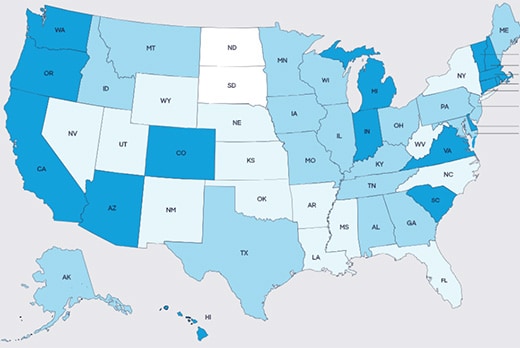Updated: Oct 20, 2023
Article highlights
- There are different types of federal student loans that are funded by the government.
- Direct Loans, sometimes referred to as Stafford Loans, are the most common type of federal student loans for undergraduate students.
- Eligibility for federal student loans is determined by filling out the FAFSA®.
The federal government offers several types of student loans to help students and parents pay for college. If you’re eligible, federal student loans will be awarded to you as part of your financial aid package once you complete the FAFSA (Free Application for Federal Student Aid). Here’s a closer look at federal student loans.
Types of federal student loans
The different types of federal student loans are:
- Direct Loans (sometimes referred to as Stafford Loans)
- Direct PLUS Loans
- Direct Consolidation Loans
Direct Loans
Direct Loans are the most well-known with two different types:
- Direct Subsidized Loan: Available to undergraduate students who demonstrate financial need, the government pays the interest while the student is enrolled in school at least half-time, during their grace period, and during periods of deferment. However, students who are awarded a subsidized loan will pay interest that accrues on the loan when it enters repayment.
- Direct Unsubsidized Loan: This loan is available to undergraduate and graduate students regardless of financial need. The student is responsible for paying all of the interest that accrues for the life of the loan.
Both types of Direct Loans have fixed interest rates and origination fees. There are also limits to how much you can borrow, both annually and in total.
Direct Loans are sometimes referred to as Stafford Loans but they are not the same. Stafford Loans were made to students attending schools that previously participated in the Federal Family Education Loan (FFEL) Program. These loans were funded by private lenders, guaranteed by guaranty agencies, and ultimately insured by the federal government. No new FFEL loans have been originated since July 1, 2010. Since then, all new federal student loans are made directly from the US Department of Education under the William D. Ford Federal Direct Loan Program. So while people use "Stafford Loans" and "Direct Loans" interchangeably, they are actually different types of federal loans.
Direct PLUS Loans
Direct PLUS Loans are available to parents of dependent undergraduate students and to graduate or professional students to help cover up to the full cost of education, less any other financial aid. A credit check is required for this loan type. But even if you have adverse credit history, you still may be able to receive a PLUS loan if you meet additional requirements. You must fill out an application for a PLUS loan in addition to completing the FAFSA.
Direct PLUS Loans have fixed interest rates and origination fees. The maximum amount you can borrow is the cost of attendance minus any other aid.
Federal Consolidation Loans
Once you are in the grace period or in repayment for your federal student loans, you have the option to consolidate. Consolidation allows you to combine multiple federal student loans into one loan so that you have a single monthly payment. Consolidation may affect your current interest rate, repayment period, total cost of the loan, and other loan factors. Visit the federal government’s Direct Consolidation Loan Application for more information.
How much can students borrow?
Annual loan limits for Direct Loans depend on the loan type, your year in school, and whether you are a dependent or independent student. Generally, as you continue your education, you are able to borrow more. For Direct PLUS Loans, the maximum amount you can borrow each year is the cost of attendance minus any other aid.
What to consider when applying for federal student loans
Federal student loans have certain features to consider. They include:
- Fixed interest rates: Federal loans have fixed rates that are set each year on July 1. The rates are based on loan type and everyone receives the same rate.
- Fees: Federal loans have origination fees (set each year on October 1) that are a percentage of the loan. This fee is subtracted from the loan before it’s disbursed, which means you receive less than you are borrowing.
- Repayment programs: Federal loans have several repayment program options, including plans based on income. Each one has its own eligibility, monthly payment, term period, and other requirements.
- No need for credit history: For Direct Subsidized and Unsubsidized loans, borrowers don’t need a credit history to be eligible. There is a basic credit check required for Direct PLUS Loans.
- Loan forgiveness options: Federal student loans have forgiveness options for borrowers who fit certain criteria. There are also programs like Teacher Loan Forgiveness and Public Service Loan Forgiveness. Borrowers will need to meet certain requirements to qualify. For more information, visit StudentAid.gov.
All federal student loans have specific terms unique to them. Reading the fine print, asking questions, and making an informed decision can help you choose the right loan for you.
How to apply for federal student loans
Here’s a look at the application process for federal student loans:
- Determine if you’re eligible: Complete the FAFSA each year you are in school. The FAFSA application opens on October 1 each year. Since aid is first come, first served, it’s a good idea to complete the FAFSA as soon as you can. There is an additional step for parent PLUS Loans, so check with your school for their process.
- Review your FAFSA Submission Summary: You’ll receive the FAFSA Submission Summary, formerly known as the Student Aid Report (SAR), after completing your FAFSA. Look it over to make sure all the information is correct.
- Look for financial aid award letters: Comparing offers can help you understand the true cost of attendance at each college.
- Apply for grants, scholarships, and other free financial aid: Before taking student loans, we recommend you continue applying for grants, scholarships, and other free financial aid that provides financial support that doesn't have to be paid back. If you still need to borrow, compare federal and private student loan options to see what best fits your needs.
FAFSA® is a registered trademark of the US Department of Education and is not affiliated with Discover® Student Loans.









